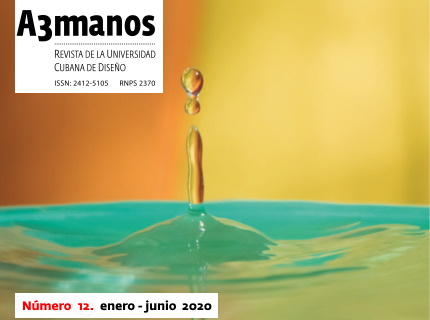The development of creativity in Design students.
##plugins.themes.bootstrap3.article.main##
Abstract
The work aims to demonstrate the importance of developing creativity in design students in the context of the Educational Teaching Process at the Higher Design Institute (ISDI), thus achieving greater professional training that contributes to the comprehensive development of their personality.
The students who enter the ISDI to train as designers are prepared, updated students with a high academic index, good cultural training and skills in the use of new technologies, in addition to choosing a career among the first options for having aptitudes and preferences towards the same, together with having a series of qualities among which we can mention: motivation, inventiveness, independence, spark, consecration, among others. It seems that they want to have a sixth sense, that is, to be creative, so to train creative designers it is essential that it be manifested and developed in the teaching process of the institution.
In order to study the ways to develop creative thinking, some ideas related to the concept of creativity, its stages and levels, as well as the main obstacles and obstacles during its practical application are presented in this work.
Finally, some recommendations are presented to educate creativity in our students based on our pedagogical experience with the aim of promoting the optimal individual development of the creative potential of each student and, in fact, producing knowledge within the framework of a developmental teaching.
##plugins.themes.bootstrap3.article.details##

This work is licensed under a Creative Commons Attribution-NonCommercial-ShareAlike 4.0 International License.
- Attribution — You must give appropriate credit , provide a link to the license, and indicate if changes were made . You may do so in any reasonable manner, but not in any way that suggests the licensor endorses you or your use.
- NonCommercial — You may not use the material for commercial purposes .
- No additional restrictions — You may not apply legal terms or technological measures that legally restrict others from doing anything the license permits.
- ShareAlike — If you remix, transform, or build upon the material, you must distribute your contribution under the same license as the original. NOTE: This point applies to numbers 1 to 20 of the magazine with the previous CC-BY-NC-SA 4.0 license. Does not apply to the new CC BY-NC 4.0 license from Volume 11, Number. 21 (2024).
References
Alonso, J. (2001) Motivación y estrategias de aprendizaje. Principios para su mejora en alumnos universitarios, en Didáctica Universitaria, Coordinador A. García Valcárcel, La Muralla, Madrid.
Álvarez de Zayas, C.(1996) Hacia una escuela de excelencia, Editora Academia, La Habana.
Amestoy M. (1991) Desarrollo de habilidades del pensamiento. Creatividad. Editorial Trillas, México.
Betancourt Morejón J. (1993) y otros, La creatividad y sus implicaciones. Editorial Academia, La Habana.
Colectivo de Autores. (2004) La Personalidad su diagnóstico y su desarrollo, Editorial Pueblo y Educación.
D`Angelo Hernández, O. (2001) Sociedad y Educación para el desarrollo Humano, Centro Félix Varela, La Habana.
De Bono E. (1991) Cómo desencadena la imaginación creativa. Editorial Pablo de la Torriente, La Habana.
De Bono E. (1998) Aprender a pensar. Editorial Garnical, España.
De la Torre, S. (1995) Estrategias de Enseñanza y aprendizaje creativo, Editorial Academia, La Habana..
Fernández Velázquez, M. (2005) La MPM y la Personalidad, Academia de las FAR, CIP.
Fernández Velázquez, M. (2006) ¿Cómo motivar a los alumnos en la clase?, Serie Temática Educación Militar No13, CIP, Academia de las FAR.
González A. (1990) Cómo propiciar la creatividad. Editorial Ciencias Sociales, La Habana.
González Serra, D. (2003) La Motivación, varilla mágica de la enseñanza y la educación. Revista Cubana de Educación (110).
Guerrero A. (1989) Curso de creatividad personal, científica y gerencial. Editorial El Ateneo, Argentina.
López Sú, Roberto. (1997) La Formación de Climas de Aprendizaje Creativos desde una perspectiva motivacional. Academia de las FAR, La Habana.
Mitjáns Martínez A. (1985) Creatividad, personalidad y educación. Editorial Pueblo y Educación, La Habana.
Marx, C. (1981) Tesis sobre Feuerbach, Obras escogidas en tres tomos. Tomo I, Editorial Progreso, Moscú.
Ortega Estévez G. y López Sú R. (1999) Una metodología para el estudio de los climas creativos. La Habana.
Suanes Canet, H. (2001) Compendio de artículos, Didáctica CIP, Academia de las FAR, La Habana.
Torre de la S. (1987) Educar en la creatividad. Ediciones Narcea, Madrid.
Viegas Fernández, J. (2002) La Educación que necesitamos. Revista Temas, (31), Ciudad Habana.
Vigotsky, L.S. (1968) Pensamiento y Lenguaje, Edición Revolucionaria, Instituto Cubano del Libro, La Habana.
Zalter, J. (2001) Estrategia de aprendizaje. Gestión del conocimiento.
Zilberstein, J., ¨y otros¨. (2002) Una concepción desarrolladora de la motivación y el aprendizaje en las ciencias, IPLAC, II Congreso de Didáctica de las Ciencias, La Habana.






















